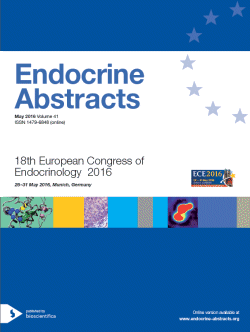Oral Communications
Diabetes prediction & complications
ea0041oc3.1 | Diabetes prediction & complications | ECE2016
Identification of a spliceosome-associated fingerprint with potential to predict development of type 2 diabetes in high-risk patients
Luque Raul M. , Gahete Manuel D. , Rio-Moreno Mercedes del , Pedraza-Arevalo Sergio , Camargo Antonio , Delgado-Lista Javier , Gracia-Navarro Francisco , Perez-Jimenez Francisco , Lopez-Miranda Jose , Castano Justo P.
ea0041oc3.2 | Diabetes prediction & complications | ECE2016
Glucose-dependent insulinotropic peptide (GIP) stimulates Glucagon-like peptide (GLP)-1 from human and mouse pancreatic islets partly via alpha-cell-derived IL-6
Timper Katharina , Dalmas Elise , Dror Erez , Rutti Sabine , Thienel Constanze , Sauter Nadine S. , Bouzakri Karim , Bedat Benoit , Pattou Francois , Kerr-Conte Julie , Boni-Schnetzler Marianne , Donath Marc Y.
ea0041oc3.3 | Diabetes prediction & complications | ECE2016
Reproducibility of fasting and oral glucose tolerance test derived parameters of glucose metabolism in non-diabetic postmenopausal women.
Van de Velde Frederique , Dierickx Anneloor , Depypere Herman , Delanghe Joris , Kaufman Jean-Marc , Lapauw Bruno
ea0041oc3.4 | Diabetes prediction & complications | ECE2016
Association of neutrophil to lymphocyte ratio with vitamin D levels in type 2 diabetes mellitus
Atile Neslihan Soysal , Yavaş Rıfat , Bilir Betul Ekiz , Bilir Bulent
ea0041oc3.5 | Diabetes prediction & complications | ECE2016
Improvement in diabetic neuropathy after metabolic surgery a comprehensive electrophysiological follow up study
Cagiltay Eylem , Celik Alper , Uzun Nurten Adatepe , Sonkaya Riza , Ugale Surendra , Kayadibi Ayca , Zengin Gulsum , Buyukbozkirli Deniz , Adatepe Turgut , Ertas Mustafa




